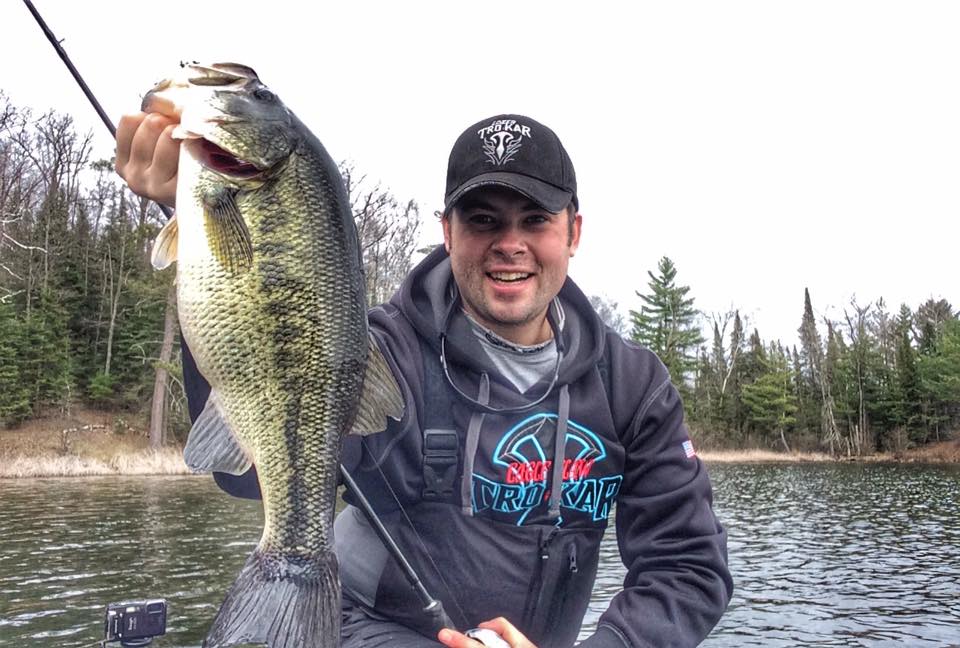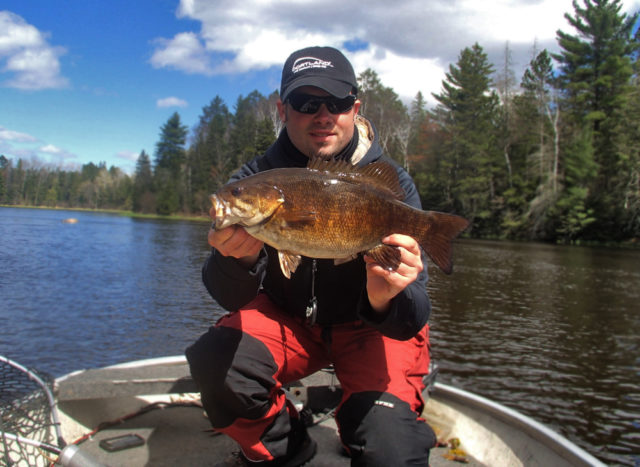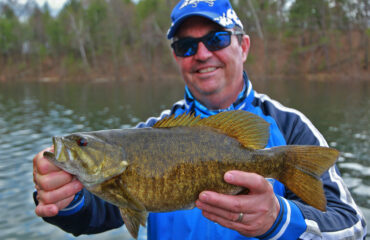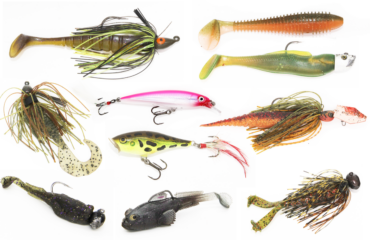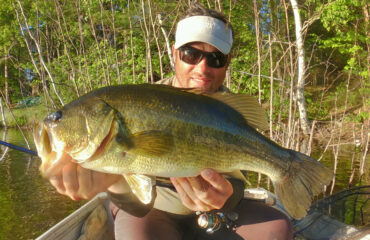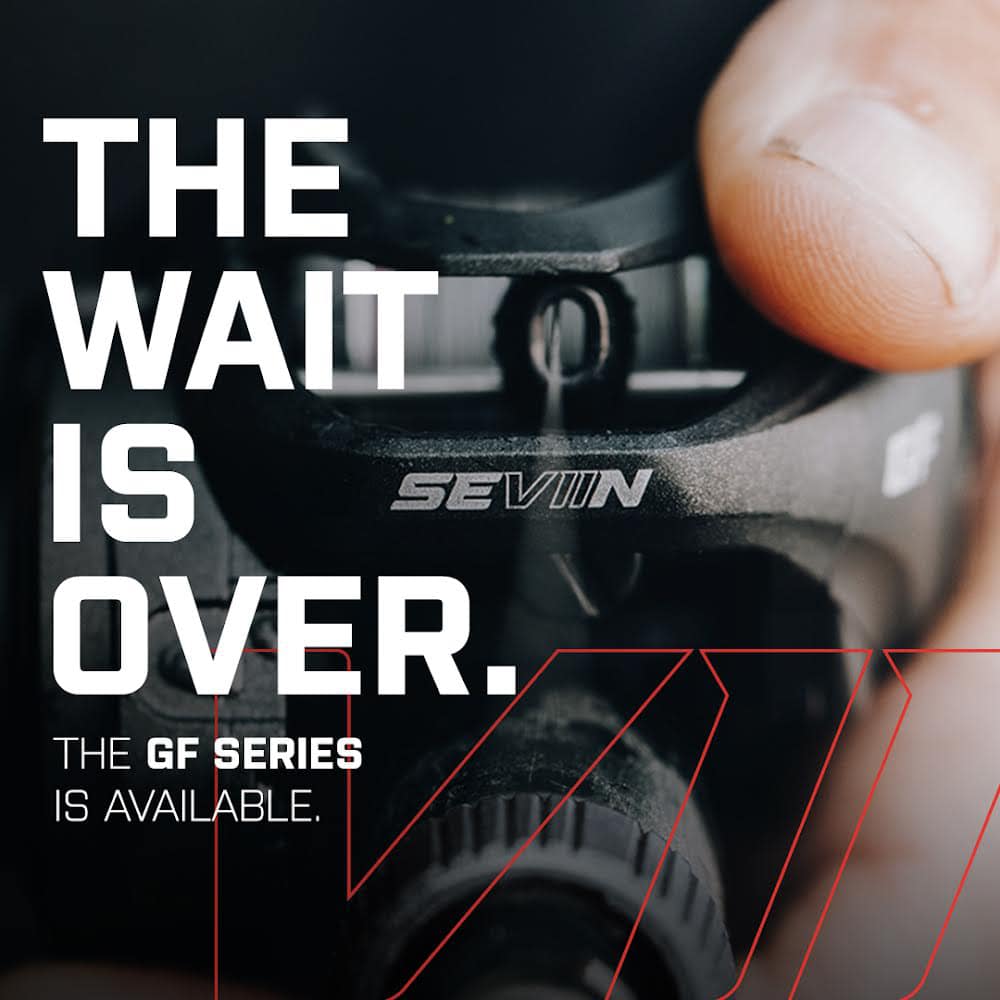Swim Jigs, Northwoods Style
Bass fishing can become as technical and complicated as we make it. Often times, anglers become too fixated on unnecessary extras rather than focusing on the presentation and strategy at hand. Like some of our fishing strategies, jig fishing can become a complicated matter due to the wide variety of jig head styles, jig designs, skirt colors, and trailer combinations available. On top of that, the availability of jigs from every major tackle manufacturer complicates the system even more!
If you’ve fished swim jigs, you might have been overwhelmed by the options that are now available. With my jig fishing program, I hope to simplify the swim jig strategy for you.
In recent years, swim jigs have become staple presentations for catching largemouth and smallmouth bass. Whether your fishing intentions are to cover water with a search lure, or to extract bass from high percentage locations that may include shallow cover and vegetation, and rock & wood habitats, the swimming jig is universally effective everywhere. Whether its head design is cone shaped or rounded, it possesses bass catching abilities in a wide range of conditions and bass waters – anywhere, anytime.
Swim jigs can represent baitfish such as shad, shiners, yellow perch, or cisco. They could even represent a crayfish, which are available in several species and different color variations. Best of all, swim jigs could represent absolutely nothing and still be effective!
The 101
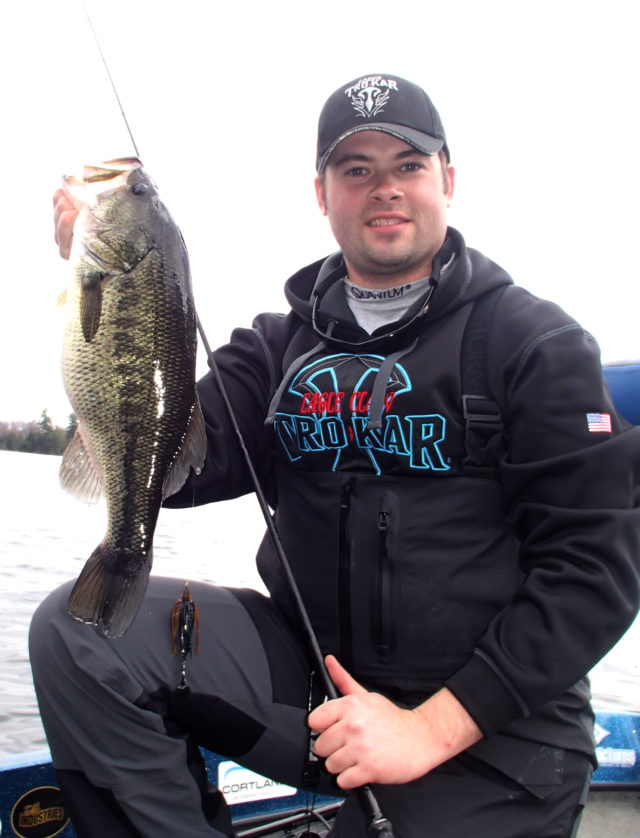
When bass are on a predominant baitfish bite in early spring and again in autumn, minnow trailers such as swimming grubs, paddletails, swimbaits, and flukes help deliver bites that are needed. Gregg Kizewski’s Super K Swim Jig with a paddletail trailer accounted for this quality 5 lb. largemouth caught during my first hour of fishing in 2017.
While pitching and flipping with heavy heads excels for bottom-oriented bass, swim jigs are designed to be cast and retrieved high in the water column. Lighter in weight, with head a design to cut through the water, they can be swam through current, vegetation, wood, rocks, and wherever baitfish and prey lurk.
The swim jig’s combination of density, compact size, and high hooking percentage caters best to being a swimming presentation. It becomes most effective paired with a trailer.
Make long casts and retrieve immediately so the jig is continuously in motion, grazing through the cover and not getting caught up into it. Hold your casting rod at the 10 and 11 o’clock position, and rip the jig anytime you feel it catching on cover and debris. When a bass strikes, drop your rod slightly and drive the hook home. A hard hook set is needed.
Swim jigs are lightweight in comparison to most other bass jigs you might have previously used. They typically run from ¼ to ½ oz, which helps keep them running higher through the water. Since they’re not being fished through snag central, most swim jigs come with a thin weedguard that promotes a high hooking percentage, and remains strong enough to deflect from snags.
I tend to fish swim jigs with a MH fast action 7 to 7 ft. 2 in. Vexan Bass and Quantum PT baitcasting rod accompanied by Quantum Icon or Energy PT reels with at least a 7.0 gear ratio. The faster gear ratio helps bring in slack line, in addition to quicker retrieve speed. Since we’re extracting bass through cover most often, I try to fish swim jigs with braided line as much as possible. Cortland Masterbraid in 20 and 30 lb. size is my preference. Sometimes I also fish the set-up with heavy monofilament such as Cortland’s Camo (15 lb.) when in more open water situations. Despite its slight stretch, mono is an advantage when fishing in clear waters, where line shy fish could stray away from swim jigs.
From early spring through first ice, there’s never a bad time to fish a swim jig, especially if you’re after big bass. Nowadays, I often substitute a spinnerbait, chatterbait, or swimbait in favor of a swim jig. When you’ve found the right swim jig with trailer, the package incorporates the best features of everything bass want to kill.
Swim Jig Strategies by Season
Spring Time: Once largemouths invade the shallows in spring to feed, they seek the best cover available in shallow bays, backwaters, and warming water sections of a lake. These habitats could consist of stumps and laydowns, reeds and cattails, emergent vegetation, piers, and the jungle-like root systems of lily pads. Swim jigs score huge numbers of fish because when perfectly rigged, with correct color combination paired with trailer, it can be utilized as a power and finesse presentation. Cone shaped heads will empower you to rip and power the jig through dense cover, with thin brush guard maintaining a weedless package.
On river systems and flowages, the swim jig is one of my favorite producers for smallmouths. On river float trips, we often drift for several stream miles. On some of flowages, we cover rocky shorelines for long distances. As a search lure, the swim jig often gets first choice.
In my neck of the woods in Wisconsin, many of these waterways are stained and dark water fisheries, and driven by abundant rusty crayfish forage. Consequently, smallmouths are fixated on craw imitators. Swim jigs with a rounded head design, and a craw profile that’s influenced by skirt color and craw or creature jig trailer, is the biggest producer. These jig shapes and styles deflect best off wood and boulders, grind and hop through rocks and holes, and can be fished deeper through holes.
Summer Time: On lakes with abundant emergent and submergent vegetation, largemouths occupy various depths that could be shallow slop locations, to deep weedlines giving way to open water. Electronics never lies, revealing edges, pockets, weed species, and prey. Additionally, boat houses, piers and laydowns can be confirmed visually. Deeper by day and shallow by night, great habitat on many lakes is obvious, and bass will feed along these areas all summer long.
Shade, ambush points, bluegills, and young of the year yellow perch are the main draws in these locations. This is the season where largemouth bass and bluegill prey connections is most obvious. A swim jig paired with a swimming grub, twintail, paddletail, or downsized creature will effectively represent a fleeing bluegill that not many other presentations could.
Fall: As the seasons undergo a change, a pattern often overlooked by northern bass anglers takes place. Beginning during the pre-turnover stages of the fall cooldown period, schools of yellow perch gravitate to shallow vegetation for sanctuary and feeding. On the prowl, hungry wolfpacks of smallmouths counter and set up along deep weedlines. On these waters, smallmouths are feeding heavily on schools of abundant yellow perch.
Swim jigs with minnow and paddletail trailers swam and ripped through the jungles, are my favorites for this style of fishing. Long casts, let it swim and fall, jerk rod up and pump it through the grass when you feel it tick the tops. But most importantly, the perch needed to be there for bass to be present. Both trailer options are fished best with slow swimming retrieves and several rips in between, giving smallmouths the effect that the bait is in distress and evading dropping down into the abyss of weedgrowth.
This fall perch pattern is underutilized and little known in my regions of the north country. Look for presence of baitfish, their heavy schools, and remaining green weeds as water temperatures cool down to the low 60’s and upper 50’s. Pre-turnover smallmouths will be lurking. Often times, you will encounter a mixed bag of largemouths too!
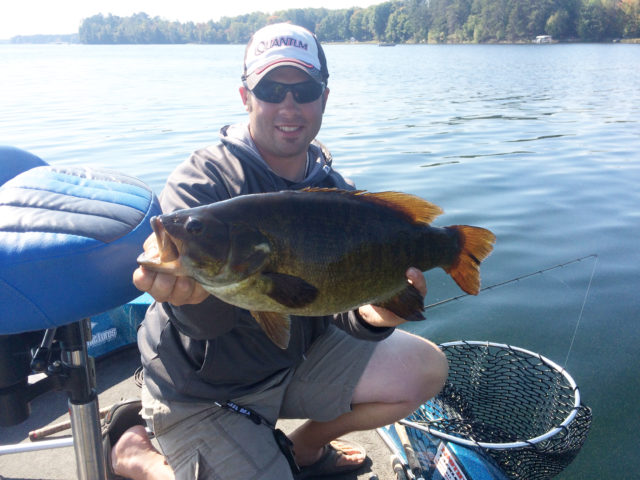
Swim jigs are a big fish bait. When paired with a correct trailer, they can represent baitfish and crayfish, or absolutely nothing and still be effective! One of the author’s largest ever smallmouths, a 6.5 pounder, fell for a swim jig combination to resemble yellow perch.
The Bottomless Pit of Jigs
This is where most anglers get carried away. Due to the popularity of swim jigs and the varied habitats anglers fish across the continent, there are too many options available. This makes our fishing become overwhelming. Where does one draw the line? Almost every major brand and custom tackle crafter manufactures a swim jig. Select only a few brands and manufacturers that cater best to your specific needs and fishing requirements. Most, if not all, head shapes and styles being offered by everyone are nearly identical. So with that revelation, your focus should then be on customized painted heads and skirt color combinations. In this regard, a few brands stand out from the crowd for me.
Mass produced swim jigs by Terminator and Strike King are available in lifelike bluegill and minnow color hues. I like their simple paint jobs and skirts for their realistic baitfish appearances and finish. This is a huge consideration on my clear water bass fisheries where more natural lifelike finesse is a tactical requirement for me, and preference for the fish.
A common theme nowadays for most bass anglers is collaborating with custom tackle crafters who can create custom colorways to best match the hatch. In recent years, I’ve partnered with independent jig manufacturers who’ve been able to paint jigs and tie skirts for me according to specification and exact colors needed. This is advantageous when patterning a specific baitfish or crayfish pattern that is lake-dependent, as most major manufacturers are unable to deliver upon these requests.
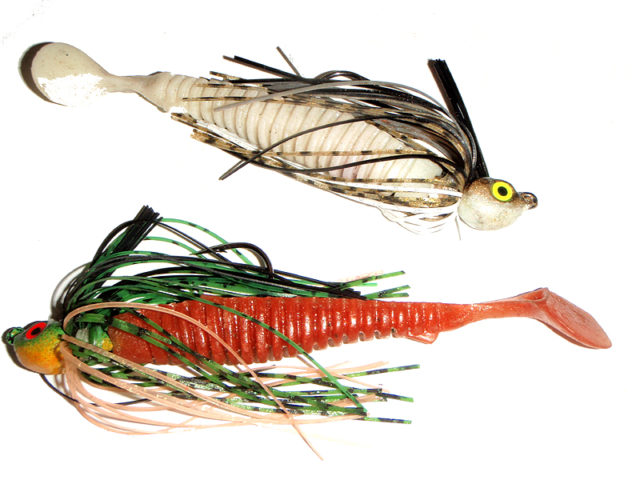
Jonn Graham’s jigs – the Warrior Jigs. Top jig resembles juvenile walleye, while bottom represents a yellow perch. Jay Kumar calls this one the “alien”.
To attack my rivers and flowages, I’ve partnered with Jonn Graham, of Bloomington, IL. Owner of Central Illinois “Camp Smallmouth” and maker of his Warrior Jigs brand, we famously concocted a popular rusty craw jig for these stained waters, and to combat Wisconsin’s rusty crayfish infestations. Graham’s heavier rounded head designs allow me to fish the jigs more effectively near-bottom in rivers and flowages as they have a faster sink rate. Graham paints his jigs utilizing a unique brushing technique and baking process, then hand-ties his own skirts using several different strands of color to create a lifelike, natural illusion. Besides rusty craw, we’ve collaborated to create yellow perch, walleye, and river redhorse colorway swim jigs in 3/8 oz. and ½ oz. sizes that have all been deadly for smallmouths in many lakes and rivers.
Another favorite independent manufacturer is locally made, Super-K Jigs, of St. Germain, WI. Prior to last year’s guiding season, owner Gregg Kizewski, kindly sent a heavy care package of his jigs for me to utilize on the region’s bass waters. I caught so many fish with his best-seller “Kizewgill”, a bluegill lookalike, until the day it no longer had a skirt left. This hot bite with an array of trailers lasted two months straight. In fact, my best largemouth of 2017 was caught on that swim jig, during my first hour of fishing in early May.
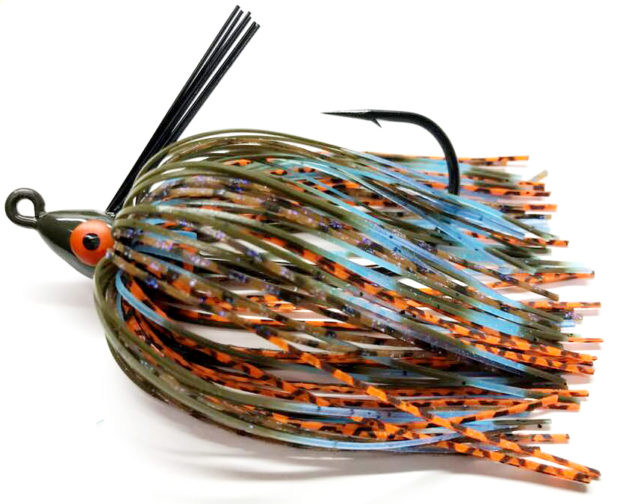
Super K jigs are 100% hand crafted by Kizewski, starting from the bare hook which he sometimes lets his customers choose the brand. Kizewski then hand pours his own lead, powder coating the heads, and baking them for a durable chip-resistant finish and sealant. Then he installs the weed guards, and hand-ties the skirts to the point of arthritic suffering, strategically placing his silicone in the proper places to make his products appear they live in the water.
Super K Jigs and I have already begun collaborations to create some rusty craw, yellow perch, and cisco jigs that will be specific to our region’s waters. Kizewski’s jig sales are all done by online ordering at superkfishing.com.
It’s no surprise why hard-core bass anglers prefer to collaborate with custom tackle crafters. Several jig makers are out there and I encourage every jig fisherman to research them for your specific jig fishing needs. Matching the hatch has never been this dead accurate in a jig fishing sense. To avoid headache and overwhelming complications, limit your jig fishing to only a few brands whose designs and colors play to your favor. Partner with independent manufacturers to then design the best jigs possible for your bass fishing and specific waters.
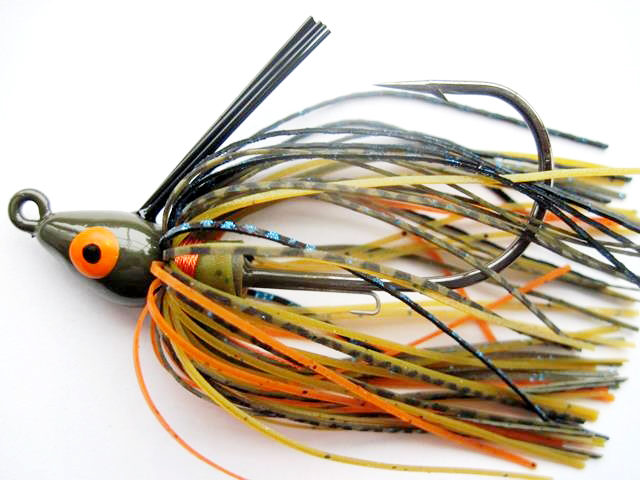
A favorite independent manufacturer is locally made, Super-K Jigs, of St. Germain, WI. Prior to last year’s guiding season, owner Gregg Kizewski, kindly sent a heavy care package of his jigs for me to utilize on the region’s bass waters. I caught so many fish with his best-seller “Kizewgill”, a bluegill lookalike, until the day it no longer had a skirt left. This hot bite with an array of trailers lasted two months straight.
Don’t Over-complicate Trailers
Besides the jig, trailers make up the other half of the package. In my opinion, this tends to become more technical than jig selection itself.
Swim jigs are a key lure for their versatility and the ability to make big bass bite. Today, the vast array of trailers enhances the versatility of swim jigs, as they can be used to bulk a presentation to resemble larger prey, improve its streamlined swimming, or to slow the fall rate.
Trailers are the business end of a swim jig, and play a more important role than the jig itself. Trailers are what ultimately trigger strikes. It’s always important to mix and match between the different variables of tail action, size, color combination, and how it triggers fish. There are so many potential trailer styles to consider, but I always fish with baits that have previously worked for me as standalone lures (a rig of its own, by itself). From there, odds are excellent that it will work great, and potentially better, when paired with a jig.
Similar to my jig size and color selection process, I like to simplify my trailers as much as possible, categorizing my jig trailers by three categories. They are crayfish imitators, minnows and baitfish, and creatures.
Crayfish: These are my top producers to rig on a swim jig for smallmouth fishing on lakes and rivers. When crayfish are molting in mid-summer, a swim jig with craw trailer will always be tied on and used as a search lure. Crayfish trailers are crawfish imitating plastics that includes plastic craws, chunks, twin tail grubs, and creature baits. My favorites for rigging consideration is a 5” Chompers Skirted Twin Tail Grub (hula grub), 3” Wave Tiki Craw, 4” YUM Craw Papi, 3.75” YUM Craw Chunk, Berkley 4” Chigger Craw, and the original SideKick jig trailer that’s no longer manufactured by Stankx Bait Co. Craw options abound, so it’s always possible match your trailer to the specific color of the crayfish forage.
Baitfish & Minnows: When bass are on a predominant baitfish bite in early spring and again in autumn, minnow trailers such as swimming grubs, paddletails, swimbaits, and flukes help deliver bites that are needed. My favorite jig trailers within this category have often been “chopped” down paddletail swimbaits, and swimming grubs. Fished through cover or swam in open water, a few specific favorites are Strike King’s 3.8” Rage Swimmer, Kalin’s 3.8” Sizmic Grub and 5″ Lunker Grub, and the 3.8” Damzel, a smallmouth favorite for my perch bites, formerly manufactured by Stankx. While smallmouth bass prefer natural, realistic and translucent finishes and colors, largemouths on the other hand have shown preference to darks, greens, blues and blacks within the minnow trailer category. I feel they see these contrasting colors best. Often, the biggest largemouths will be triggered by a larger bulkier trailer. I like to overpower them in spring and summer with a big swimming grub like the 5” original Thug Grub and Swimz and Swankx Paddletails, formerly manufactured by Stankx.
Creatures: In murky water clarities and weedy jungles, baits that move too fast may avoid a bass’s strike zone before it could see it and strike. In these situations, I like to slow my retrieve speed and tip the jigs with creatures. Creature baits encompass crayfish variations, and often don’t resemble anything living in the wild. What makes them work is their appendages and tails, and bulkiness that helps add size and greater profile to the swim jig. A few favorites of mine are 4” YUM Wooly Bugs and Wooly Hawgs, and Gene Larew’s Biffle Bug. These specific trailers will be dark colors, always.
What I often do with swim jigs is if one particular trailer or style hasn’t triggered or generated strikes within the first 10-15 minutes, I quickly swap trailers to a new variation or one entirely different. I’ve previously changed trailers and gone from barely any bites to catching several big ones the rest of the day. Bass fishing can be stupid simple at times, in ways that fish will often respond and strike immediately following the switch.
Jig fishing for bass is a creative strategy. So many colors, head styles, skirts and trailer combinations to choose from. Where does one begin? Best advice I’ll give you is don’t settle on just one jig, and don’t ever be picky. Limit your swim jig selection like I have, to only a few brands and some basics, so you can focus your mind and your eyes on finding bass and delivering them a careful and accurate presentation. While on the water, adapt and adjust your swim jig package accordingly. Let the bass ultimately choose the right jig pattern, and trailer for you!


